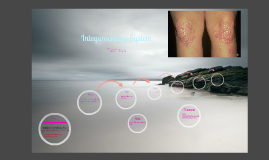Integumentary System
Transcript: Integumentary System The skin, hair, and nails! The skin provides multiple functions for the body. It repels water, guards infection, helps maintain homeostasis, and senses the environment. It also provides a minor protection to the sun's rays and helps the skeletal system by producing vitamin D when in sunlight. The epidermis is the outer layer of the skin that gives it its tough, protective qualities. Skin cells are made at the base of the epidermis and move upwards as new cells below them form, so every 2-4 weeks, the surface of your skin is new. Consequently, surface cells of your skin are dead, but provide a thick, waterproof layer about 30 cells deep. Blood vessels supply blood to the skin. They enlarge when you're too warm to increase blood flow, which in return helps you cool down by letting the heat travel to the outside faster. The increase in blood flow is why when you are exercising hard, some people's cheeks turn red. This is an example of the skin interacting with the circulatory system. Sweat glands and oil glands are everywhere on the body. Sweat glands secrete sweat that is 99% water onto the skin's surface through pores. The sweat evaporates and cools the body, thereby maintaining homeostasis. Oil glands secrete oil that moisturizes the skin and hair, provides flexibility, and part of the skin's waterproofing. The dermis is the middle layer of the skin. It is made of an elastic - like tissue that is strong. Blood vessels run through this layer and supply nutrients, and this layer also has sweat glands, oil glands, sensory receptors, and the skin begins growing here. Sensory receptors are nerves in the dermis that sense the outside and inform the body. This is one way the skin interacts with the nervous system. Fatty tissue is the bottom layer of the skin that protects the body from extremes and stores energy. The skin consists of three layers: The epidermis (which is the outer layer), the dermis (which is the middle layer), and the fatty tissue (which is the inner layer). The hair grows from follicles located in the dermis. It shields the body from the sun and traps heat. Like surface skin cells, cells in the hair and nails are dead. Fingernails and toenails protect the tips of the fingers and toes from injury. They are made from epithelial cells that grow from the nail bed as the cells that form the bed bond and grow. Two common diseases that can happen in the integumentary system are skin cancer and acne. As previously stated, the skin can provide minor protection against sun rays. This is because of the specialized cells that make a pigment called melanin that absorb its rays. More melanin is produced when the skin's exposed to the sun and in turn causes your skin to turn darker, which is why people get tanned. However, these cells can get damaged easily by continuous exposure to sun without protection. When they get damaged, they can mutate and divide uncontrollably, which is what causes cancer. Skin cancer is treated in the same way that many other cancers are. Surgery can be used to remove the tumor, and radiation can also be used to kill the cancer cells. Chemotherapy can also be used. There are two types of chemotherapy: for cancers only on the top layer of the skin, creams or lotions can be applied, and for more severe cancers, systemic chemotherapy (drugs taken in through injection or swallowing) can be taken. Acne is a disease that affects many people. It can be caused by overproduction of oil, irregular shedding of dead skin which can aggravate the hair follicles of the skin, and a buildup of bacteria. It can also be worsened by hormones from the endocrine system, which occur during puberty, and by a bad diet. However, it is not affected by dirty skin or greasy foods, contrary to the myths. Acne is very treatable. If the acne isn't very severe, regular over-the-counter acne lotions can be used that dry up oil, kill bacteria, or slough dead skin cells. These products could contain ingredients like benzoyl peroxide, sulfur, or salicylic acid. For more severe cases, topical prescription medications, ingested antibiotics that fight bacteria, or light or laser therapy that damages oil glands to reduce oil or target bacteria that cause acne can be used. The integumentary system could be compared to a house. The walls of a house could be viewed as the epidermis, dermis, and fatty tissue as they both provide a protective layering. Water pipes in a house could be compared to the blood vessels in the skin as they both provide important supplies. The air conditioner of a house and the air vents could be viewed as the sweat and pores of a body; they both cool their respective systems. A monitoring system could be viewed as the sensory receptors because they provide information. Finally, the humidifiers in a house could be viewed as the oil glands because they provide moisture. Sources: Hude, Patrice. "Acne." KidsHealth. The Nemours Foundation, n.d. Web. 01 Dec. 2012.

















